A national park with largest natural lake created by karst formation, offering scenic a scenic boat trip, exploration of huge unspoiled stalactite cave and an homestay experience at the local village of the ethnic Tay people.
Ba Be National Park extends over an area of 70 sqkm in Bac Kan Province, featuring a landscape of low limestone mountains of around 600 to 900 high, covered by tropical jungles and vegetation. The highest rock in the region being the Phja Bjooc reaches an altitude of 1546 m. The park boasts a large diversity of fauna and flora including 100 different species of birds, 30 species of mammals and some other species threatened with extinction. There are scattered Tay settlements in the buffer zone around the park, most popular to tourists being the Tay village in Pac Ngoi which perches on the bank of the lake.

Ba Be Lake
At 145 meter above sea level, the 500 hectare karst-formed lake is the largest of its kind in Vietnam. The lake is connected to the Nang River which flows through Dau Dang rapids. In the rainy season, water flows from the lake into the river; in the dry season, however, the river feeds the lake.
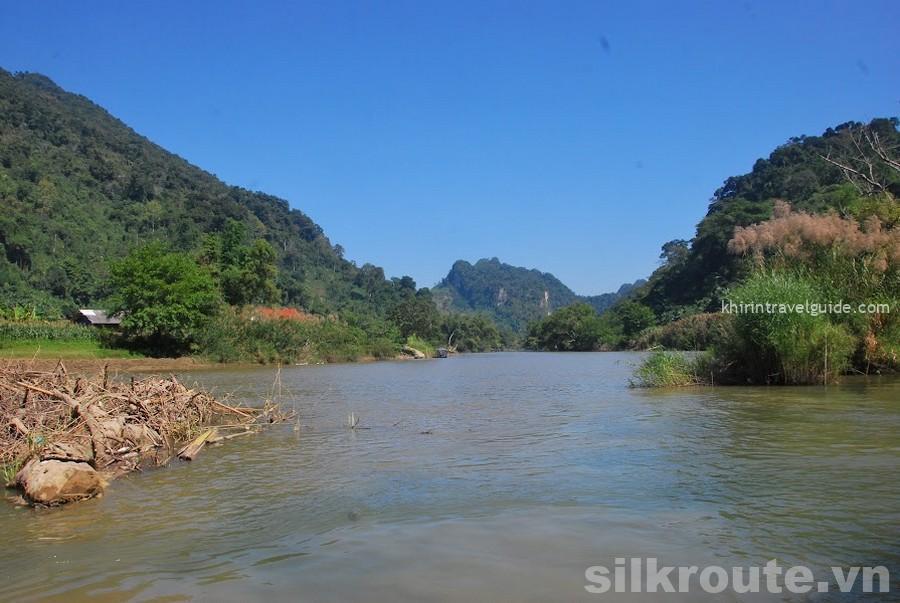
There are also a few grottoes, the most famous of which is the Puong Grotto. Boat trips on the lake are the highlight of a visit here. Boat trips on the lake are the highlight of a visit of Ba Be Lake.
Making your way to Ba Be National Park
The headquarters of Ba Be Nation Park is located approximately 230km from Hanoi, or 80km from Bac Kan the provincial capital city.
– Arriving via Cho Ra is most convenient for those travelling southbound from Cao Bang or northbound from Bac Kan. Travelling on QL3 into the town of Phu Thong, turn west and follow TL258 for 34 km to reach Cho Ra. From here follow QL279 for 9 km to reach Buoc Lom Dock, and straight another 9 km to reach the Park Center Dock on the northern bank of the lake.
– However there is one other alternate route from Bac Kan to Ba Be via Cho Don. From Bac Kan follow TL257 for 42 km to Cho Don. Here follow TL254 for 37 km to reach the boat dock in Bo Lu, and another 1.8 km to the boat dock in Pac Ngoi.
There are ticket booths for lake visit set up at every docks and also on TL254, but if you just travel through or else come to visit the Hua Ma Cave without doing the boat tour you don’t have to buy this ticket for the lake.
Your choices of boat tours in Ba Be Lake
Depending on how much time you have, you may opt to do one of the official pre-designed trips as follow:
– Route 1: Dock – An Ma Temple – Fairy Pond – Puong Cave – Dau Dang Rapids (max 5 hours)
– Route 2: Dock – An Ma Temple – Fairy Pond – Puong Cave (max 4 hours)
– Route 3: Dock – Fairy Pond – An Ma Temple – Dau Dang Rapids (max 3 hours)
– Route 4: Dock – An Ma Temple – Fairy Pond (max 2 hours)
– Route 5: Dock – An Ma Temple (max 1 hour)
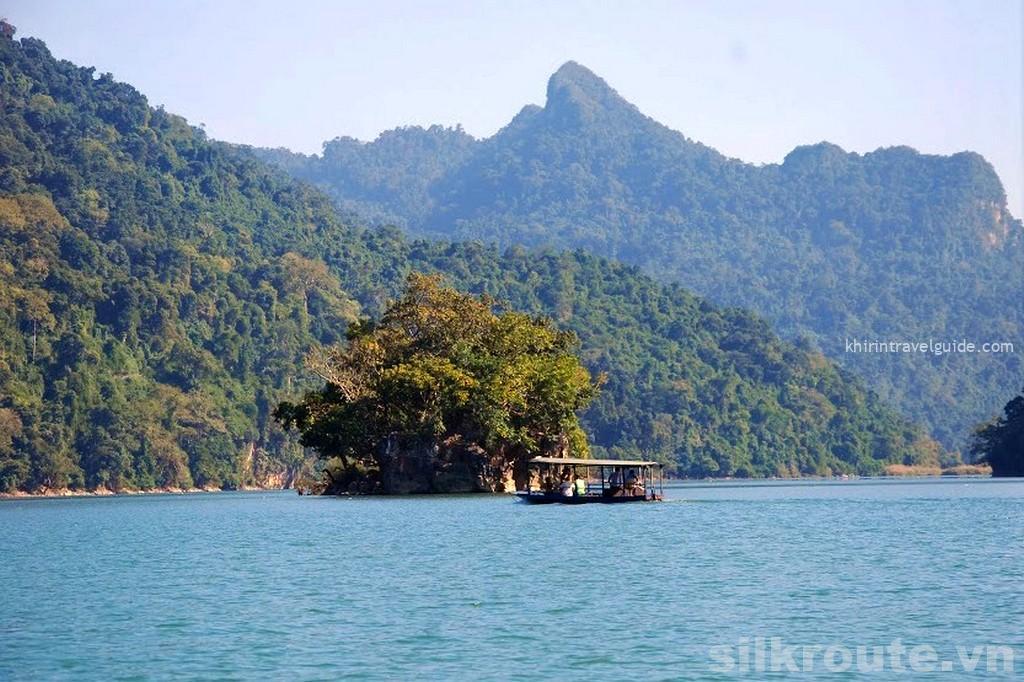
I explain the places for you below:
– Dock: There are a number of boat docks around the lake but most used are those in Buoc Lom, Park Center, Pac Ngoi and Bo Lu depending on from where you approach the lake.
– An Ma Temple: a small and very simple shrine without much to see on top of a little island not far from the dock. Weird enough, local tourist like to take check-in pictures on the floating pier. We do not recommend to do Route 5 as the An Ma Temple is too close to the dock and what you see doesn’t worth it.
– Fairy Pond: a small body of water isolated from the lake. It is has the shape of an eclipse measuring 177m in length and 100m across. It is not a big draw but the scenic 5 km boat ride is enjoyable.
– Puong Cave: an impressive half submerged tunnel eroded by Nang River through the karst mountain of Lung Nham. The cave measures 300 meters in length with a huge 30 meters high palate. There is a rocky foot path inside with steep edge going along the river. It is only 4 km by boat from Buoc Lom but nearly 12km from the Park Center Dock.
– Dau Dang Rapid: Incorrectly called a waterfall, Dau Dang is actually a 200 meters long section of rapids on Nang River about 10km downstream from the Park Center Dock. The rapids are only good to see in high water season around May to August when Nang River has strong flow.

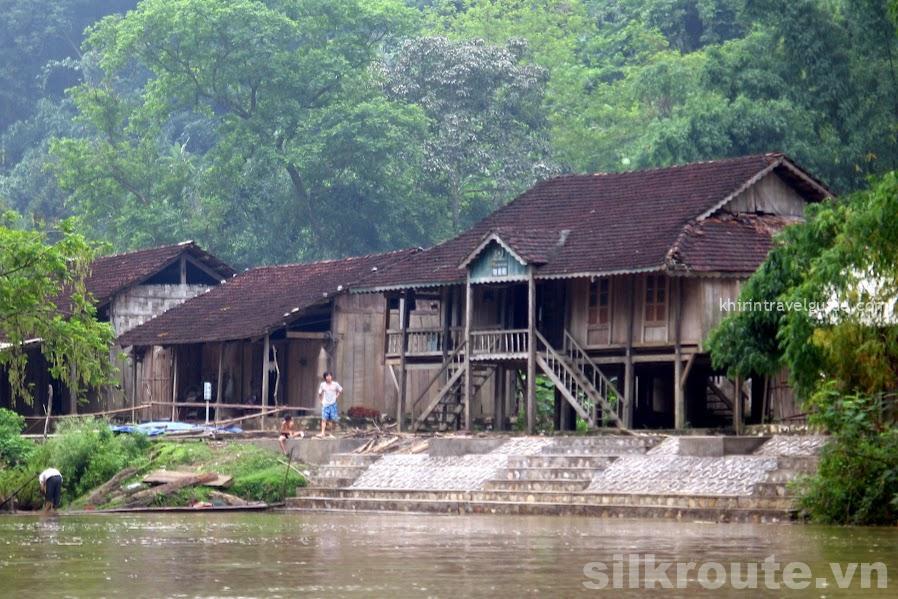
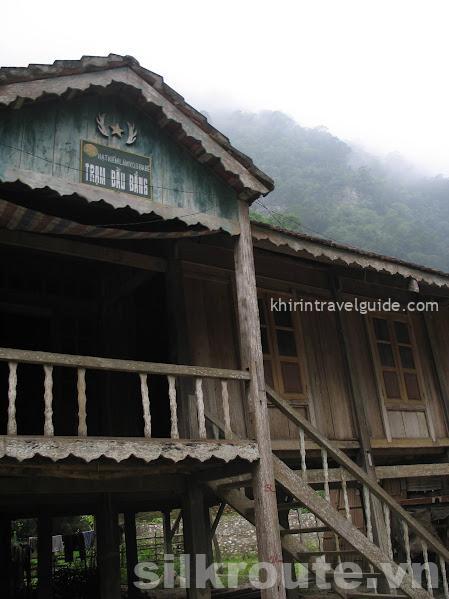
If you look at the map, you will find that you can save time by doing one way boat ride from Buoc Lom to the Park Center Dock or reverse direction.
Nearby toward the east of the lake hidden the Hua Ma Cave, a natural wonder and a highlight of the park. Toward the west, the lake is connected to Nang River via the small rapids in Dau Dang. On this side, Puong is another cave which is also impressive for it sizeable palate.
Pac Ngoi Village
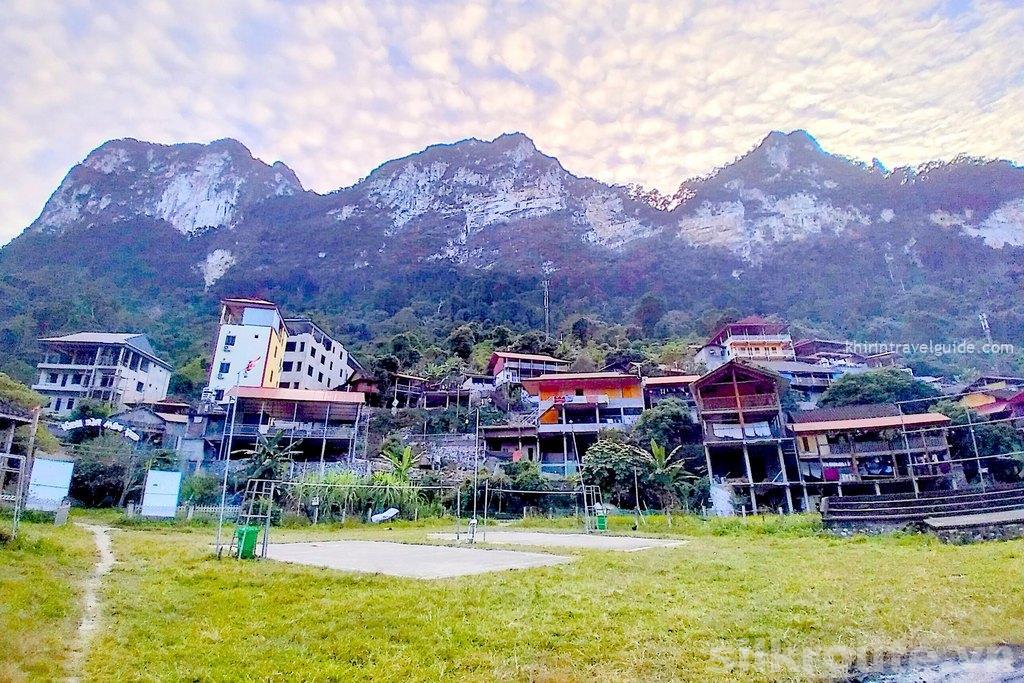
Pac Ngoi Village has 80 households totaling 400 people of the ethnic Tay who earn the living primarily by fishing on the lake and the connecting Nang River. However, this is supplemented by rice agriculture and animal husbandry, with many of the homes having large rice fields and animals located nearby. Today the village is a great place to spend a night or two in the homestays, while the day time is to explore the lake and the beautiful Hua Ma Cave nearby. From the main boat dock on the north side of the lake, follow the road sign going round to the southern side where the village is located. There is a hanging bridge which has a clearance of 2.3m high and only allows vehicles below 2.5 tons in weigh.
Hua Ma Cave
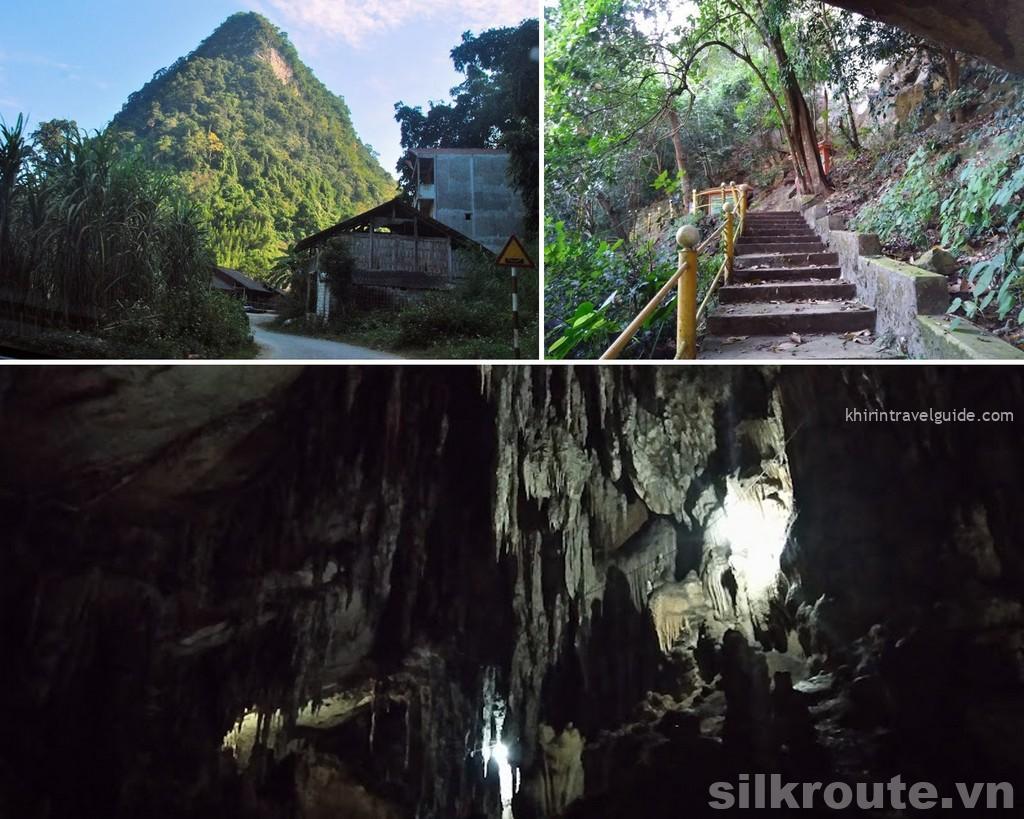
The entrance of Hua Ma Cave is suspended on the side of a huge limestone outcrop located 5.6 km from Pac Ngoi Village. Visitor must walk up more than 400 steps to reach the opening to enter, and about that number of steps on a winding course to go down to the cave floor. Inside it is inadequately illuminated, but with a good flashlight you can see a huge chamber with the height of some 40-50m from bottom to ceiling. There are large broken clitters in the center of the interior and lots of magnificent stalactites and karst pillars. Be sure to carry a tripod and good flashlight if you are keen on taking some photos inside.
FACTS
Ba Be, a sprawling expanse covering 10,048 hectares, earned its status as a National Park in 1992 and later secured its place as an ASEAN Heritage Park. Enshrined within the park’s heart, Ba Be Lake comprises three smaller lakes originally “slam pe” in the local Tay language. The three lakes – Pe Leng, Pe Lu and Pe Lam – are indeed three sections of the same water body. Ba Be Lake is Vietnam’s third Ramsar site as listed by UNESCO, elevating its status as a vital global wetland. Nestled at 145 meters above sea level, with an average depth of 20 to 25 meters and a maximum depth of 35 meters, Ba Be Lake reigns as Vietnam’s largest tectonic lake created by the collapse of the late Cambrian karst formation. The majestic karst limestone massif harbors captivating caves within their depths.
The Park
- Location: Bac Kan Province, 250km northeast of Hanoi.
- Area: 10,048 hectares.
- Status: National Park since 1992, ASEAN Heritage Park since 2003, Ramsar since 2011, Special National Vista 2012.
- Habitat type: tropical evergreen forest on limestone mountain.
- Climate: Vietnam’s Northeast Climatic Subregion.
- Seasons: 2 seasons (dry and rain).
- Annual mean temperature: 22oC.
- Annual rainfall: 1,378 mm.
- Humidity: 80%, influenced by the northeast monsoon.
The Lake
- Type: fresh water.
- Area: 450 hectares.
- Length: 7.5km, width: 1.2-1km, depth: 17-23m, deepest point 29m, water level difference: 2.8m.
- Elevation: 145 meters above sea level.
- Special: Vietnam’s largest tectonic lake created by the collapse of the late Cambrian karst formation.
Biodiversity (2012)
Flora
- Species count:
- Terrestrial plant: 909 species
- Aquatic plant: 179 species
- Endangered species:
- Aglaia pleuropteris/Ngâu rừng /CR
- Craibiodendron scleranthum/Hoa khế/VU
- Dalbergia bariensis/Burmese Rosewood/Cẩm lai/EN
- Hydnocarpus annamensis/Nhọ nồi Nam bộ/VU
- Remarkable old trees in the Park
- Burretiodendron tonkinense/Nghiến
- Tetrameles nudiflora/Đăng, tung, thung, sprung
- Dracontomelum duperreanum/Indochina Dragonplum/Sấu
- Ficus racemosa/Cluster fig/Sung
Fauna
- Species count:
- Animal: 40 species
- Bird: 233 species
- Reptile: 27 species
- Amphibian: 16 species
- Fish: 107 species
- Insect: 355 species
- Endemic species:
- Paramesotriton deloustali/Vietnamese Salamander/Cá cóc bụng hoa
- Aglaia pleuropteris/Ngâu rừng/CR
- Hydnocarpus annamensis/Nhọ nồi Nam bộ/VU
- Some in the IUCN’s Red List:
- Chrotogale owstoni/Owston’s Civet/Cầy vằn/VU
- Trachypithecus francoisi/François’s Langur/Voọc đen má trắng/EN
- Paramesotriton deloustali/Vietnamese Salamander/Cá cóc bụng hoa/VU
- Quasipaa spinosa/Chinese Spiny Frog/Ếch gai sần/VU
- Other strictly protected species:
- Nycticebus pygmaeus/Pygmy Slow Loris/Cu li nhỏ
- Hemigulus ownstoni/Owston’s Banded Civet/Cầy vằn
- Chrotogale owstoni/Owston’s Palm Civet/Cầy vằn bắc
- Ursus thibetanus/Asian Black Bear/Gấu ngựa
- Lutra lutra/Eurasian Otter/Rái cá thường
- Phataginus tricuspis/Short-tailed Pangolin/Tê tê
- Scotomanes ornatus/Harlequin Bat/Dơi đốm hoa
- Ophiophagus hannah/King Cobra/Hổ mang chúa
- Big-headed Turtle (Platysternon megacephalum/Rùa đầu to)
- White-eared Night Heron (Gorsachius magnificus/Vạc hoa)
Ethnicity
- Tay: 57%
- H’mong: 37%
- Dao and Kinh as minority.






